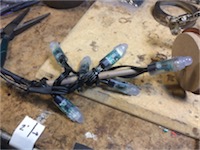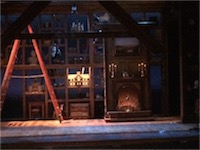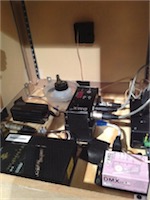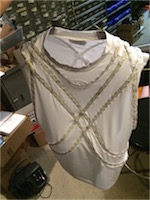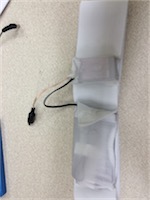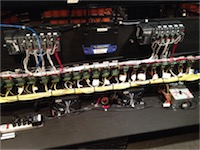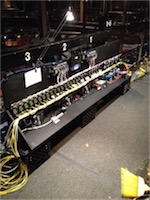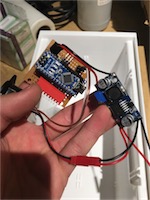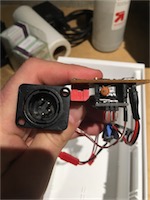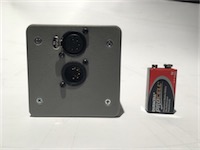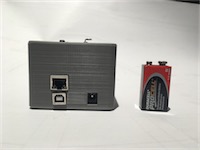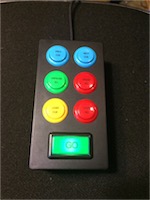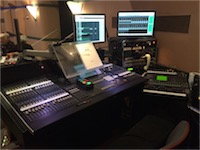Special Projects
I have worked on a number of special projects, primarily props and scenic elements for shows at the Wirtz Center for the Performing Arts at Northwestern University. These projects have required careful planning and coordination with designers and shop colleagues, as well as extensive research and development. Below are some favorite projects I've helped design and build.
Props/Set dressing
- Mason Jar Fireflies
- Olympic Cauldron
- Light-Up Bookshelves
- "Magic" Fluorescent Lights
- Grandfather Clock
- Wall of Stars
- Ferris Wheel
Costumes
Scenery Automation
Lighting & Sound Hardware
Mason Jar Fireflies, The Grapes of Wrath, Wirtz Center - The lighting and scenic designers asked for mason jars with fireflies in them. The scenic designer found a product that he liked, but did not fit within our budget given the number of jars he wanted. I designed and wired an alternative that ended up working even better because the lighting designer could control the color, rate, and randomness of the twinkling precisely and program it into the lighting console. The jars were wired with individually-addressable RGB LED pixel nodes into a structure built for me by the properties department. Total cost of the electrics part of the project was under $100. Below are photos of the construction process as well as videos of the jars being tested/demonstrated.
Olympic Cauldron, Waa-Mu 2015: GOLD, Wirtz Center - The scenic desiger created a set reminiscent of the 1936 Berlin Olympic stadium, including the torch. The lighting designer asked for it to be functional, but due to obvious safety concerns it had to be simulated flame. The properties supervisor and I designed an effect using RGB LED fixtures, a compact fog machine, and blower fans tucked inside the cauldron to create an impressively realistic-looking flame. The entire torch was able to fly in and out during the show. Below is a photo of the layout of the components, as well as two test/demonstration videos of the effect as we were building and refining the prop.
Light-Up Bookshelves, Little Women, Wirtz Center - The scenic design for this show involved 66 bookshelves, many of which contained objects related to scenes from the play. The lighting designer asked for the ability to highlight each of the shelves individually with an "inner glow" effect. With help from my student crew, I wired side-emitting LED strip to a 96-channel LED dimmer to accomplish the individual control required. Additionally, there were dollhouses on some of the shelves representing locations in the play that also had LEDs inside so the windows could glow as if the houses were occupied. Total cost of the project was less than $200. Below are several photos taken during tech rehearsals showing the effect.
"Magic" Fluorescent Lights, American Idiot, Wirtz Center - The lighting designer asked for fluorescent fixtures with real fluorescent tubes inside them, but could also change colors and chase like a low-resolution video wall. I designed and built fixtures with LED pixels hidden inside them - 140 per fixture, almost five universes of DMX in all - yet the total cost of the project was under $150. Below is a video of the fixtures running a test effect, as well as a photo of them installed in the scenery.
Grandfather clock, The Pajama Game, Wirtz Center - I designed and installed RGB LED lighting for the three clock faces, fog and pneumatic solenoid control for "steam" vent, clock speed control (including building and programming an Arduino DMX decoder and timer chip to control the three electric clock mechanisms), RC4 wireless DMX control of every component, battery power systems, and MIDI show control integration of sound, lighting, and fog cues programmed into the lighting console and sound playback system.
Wall of Stars, The Laramie Project, Wirtz Center - The back wall of the set for this show was made of wooden slats. For the final moment of the show, the lighting designer asked for the wall to be able to turn into a sky full of stars. We wired an assortment of several hundred grain-of-wheat and grain-of-rice lights into high-density LED dimmers, which I then turned into a pixel map on our ETC Ion lighting console and made them twinkle using a dynamically-rendered Perlin noise effect so the pattern never repeated. Below are two videos of the effect, one shot in darkness and one with some stage lights on so the wall is visible.
Ferris Wheel, All Shook Up, Wirtz Center - The design team asked for a functioning scale-model ferris wheel that could be pulled on and offstage without an umbilical. Construction was done by the Wirtz Center properties department, then I installed 70 grain-of-wheat lamps with a slip ring at the axle to allow for continuous rotation and a wireless dimmer for control; designed, constructed, and programmed an Arduino-based stepper motor speed controller based on wireless DMX input, and designed and implemented a high-capacity battery system for the power-thirsty incandescent lamps and motor.
Glowing Shirts, Danceworks 2014, Wirtz Center - The choreographer and lighting designer for the dance piece requested shirts that could glow and pulse and be remotely controlled. I figured out how to waterproof and reinforce LED tape so the costumes could be danced in, sweated through, and washed. The final costumes included a loose and gauzy outer layer to diffuse the intense points of the LED light. The LEDs were wired to tiny RC4 wireless dimmers connected to small but powerful Lithium Ion battery packs strapped to the dancers' backs.
Fire Hand, Moby Dick, Wirtz Center - This is another quick example of an effect I am asked to create fairly frequently: "Please make costume piece XYZ glowy!" (And occasionally the request - as in this case - comes the day before opening!) This particular effect was designed to make it look like a character was holding St. Elmo's Fire and making a harpoon tip spontaneously burst into flames. I wired RGB LED strip to an RC4 wireless dimmer attached to a battery, then the costume shop sewed it into a glove with corset boning for rigidity. Quick, easy, simple, but effective!
Scenery Automation, Pride & Prejudice, Wirtz Center - This project involved moving paper over 26 drums, each with its own small stepper motor, and swagging the panels out over the stage and house with four gantries, each outfitted with a larger stepper motor. I was responsible for the design and wiring of the electrical systems, while the properties supervisor handled the PLC programming. The photos below show the control board used to drive the motors. The final effect can be seen in the video below.
Columns/Trees (Scenery Automation), As You Like It, Wirtz Center - This project was another great inter-shop collaboration. The scenic designer wanted tall square columns to be able to open up into abstract trees when the location transitions from the court to the forest. The carpenters devised an ingenious internal opening mechanism, I did the wiring for motor power/control and limit switches, and the properties supervisor handled PLC programming. The entire automation system was able to be controlled from the lighting console via UDP commands over our network. Below are several videos of the automation under stage light and with work light (the lighting cue was fairly dark and not camera-friendly), as well as a photo of the "trees" with string lights hanging between them.
TV Reveal, The Laramie Project, Wirtz Center - This was our second foray into scenery automation. For the moment when the news media decends upon Laramie, WY, four doors in the wall opened to reveal TVs playing news coverage of the event, as well as a large winch backstage that lowered four flatscreen TVs from the grid. I helped design and wire the control system to run the motors and winches, and devised a counterweighted pulley system for video and power cable management for the flying TVs. There are two videos below showing the effect under both work and stage lighting (please note, the TVs are not playing any content in the videos as they were during the performance).
DMX-Controlled Variable Speed Mirror Ball Rotator - We use mirror balls surprisingly frequently in shows at the Wirtz Center, and the designers always used to complain that the stock mirror ball motors we had moved too fast, weren't adjustable, and couldn't change direction (yes, some designers are very specific about that!). To remedy this, the properties supervisor and I set about designing and building a motor that met all of those requirements. The final result uses a geared-down continuous rotation servo motor driven by an Arduino Nano getting opto-isolated DMX data and power from a color scroller power supply, contained in a custom-designed, 3D-printed case. It can run both clockwise and counter-clockwise from about 1/4 RPM to 7 RPM, and is addressable via dipswitches on top of the enclosure.
sACN to DMX Converter - we have two licenses for ETC Nomad, a computer-based lighting console, but no way to output the streaming ACN protocol they use to DMX, the language spoken by our dimmers. We could not afford a product like an ETC Gadget or Net3 node, so I set about creating a converter based on Arduino and open-source conversion libraries. The final result uses an Arduino Uno with an Ethernet shield and a DMX shield I had lying around, contained in a custom-designed, 3D-printed enclosure. Total cost of the project was under $40. Photos are below, with battery for scale. Unit can be reprogrammed via USB, and powered via USB or barrel connector.
QLab/MSC Controller - we use QLab to control audio playback and show control for all of our shows at the Wirtz Center. I wanted a dedicated controller for the software that I could attach to the sound console instead of needing to reach for the computer keyboard to trigger cues. This final result uses rugged buttons designed for video poker machines, attached to an Arduino Uno running code I wrote, with custom firmware that I compiled loaded on the USB controller chip that allows it to be seen by the computer as a native USB-MIDI device that doesn't require device drivers to be installed. It features an illuminated "GO" button with built-in double-go protection. The unit sends standard MIDI Show Control commands, so while I designed it for use with QLab, it will work with any software that responds to MSC triggers. Another bonus of this controller is that it triggers QLab regardless of whether it is the active application - useful because I am generally running Wireless Workbench and Dante Controller on the same computer while engineering shows.
